|
"We had violence, but he had an understanding of it. But it has to do more with the emotional violence rather than the physical violence. The emotional violence is the promise of violence in a way. It's the process of the violence that's going to erupt. And White Dog is a perfect example of that pure emotional violence. The whole idea of a dog that's trained to kill black people... I mean, just the idea of that is what I'm talking about, emotional violence. You don't have to see it happen in the film, the whole concept of it is horrifying. Sometimes it doesn't erupt – it's much worse. It's much worse." |
|
Martin Scorsese on Samuel Fuller in the documentary
The Typewriter, the Rifle & the Movie Camera |
Many go out of their way to avoid getting political when writing reviews of films, largely, I suspect, to avoid offending even the smallest proportion of their readership in their drive to push their Twitter following up as high as it can go. I, as regular readers will doubtless be aware, am not one of those people. I am, by nature, a political animal, an angry young man who grew older but not calmer and who believes that stupidity, injustice and self-interest should be directly challenged at every turn. With that in mind let's set a basic ground rule here: racism is one of the most insidious expressions of human stupidity, and a potentially deadly one. You claim to hate someone not because of anything they as an individual have done to you or your family, but because their skin is a different colour to yours? Fuck you. You're a moron, and a dangerous one at that.
Yet intolerance and racism is on the upsurge again. Experts in these matters assure us that in times of austerity, people look for scapegoats and tend to target those whose nationality, lifestyle or appearance differs from theirs, which frankly is the behaviour of stupid and easily manipulated sheep. And boy are there a lot of dopey lambs out there at the moment. Some are even building their entire election campaign around these carefully generated propagandist fears. You know who you are. Turn up at my door at election time spouting your shit and you'll find out just who I am too, matey.

Too often those who spout even casual racist dirge have never had to experience what such attitudes can lead to, and have no concept of what it's like to be on the receiving end. In the space of just a few weeks, a Kenyan friend of mine was loudly and verbally abused while waiting for a bus, spat on while travelling by train, and aggressively threatened and then physically assaulted while waiting for a friend outside a nightclub, all because his skin is darker than that of these white aggressors. I can report with some pleasure that he is also in far better shape than his persecutors and an accomplished boxer, as the nightclub idiot discovered to his considerable cost.
Racial equality was an issue that was dear to the heart of the late, great Samuel Fuller. A committed integrationist, he was regularly casting black actors in fully rounded and non-stereotypical roles when others were consigning them to bit parts as butlers, crooks and slaves. In a key scene in his astonishing 1963 Shock Corridor he tackled the subject of racial hatred in a deliberately provocative and confrontational manner, one seemingly designed both as an accusatory shout against still widespread societal racism and as a wake-up slap for well-meaning but politically inactive liberals. But nowhere are his views on the continuing racism in his homeland more directly addressed than in the suggestively titled 1982 White Dog.
It begins at night on a deserted highway when young aspiring actress Julie (a sparky and self-confident Kristy McNichol) accidentally collides with a handsome white German Shepherd dog. After taking it to a vet and forking out for its treatment, she takes it home and puts up posters in the hope of being contacted by its rightful owner. But when a serial rapist breaks into her house that night and assaults her, the dog responds by bringing the man down. She decides to keep the animal, but one day it runs off, and unbeknown to Julie viciously attacks a truck driver...
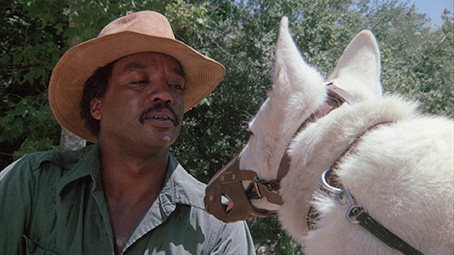
If you come to White Dog with little or no foreknowledge of its content, then at this stage you could be fooled into thinking you're watching a straight-up exploitation movie, the "Jaws with paws" that witless Paramount executives had wanted back in the project's early days. It certainly ticks a few exploitation boxes, with the appearance of the rapist in Julie's bedroom in particular driven more by the need to move the plot forward quickly than realism or even real world logic. And at this point the fact that the truck driver is black carries no particular weight – 80s exploitation movies were equal opportunity providers when it came to casting their victims. But when the dog attacks Julie's black friend Molly while the pair are at work, her concerned new owner pays a visit to veteran animal trainer Carruthers (Burl Ives), who informs her that she has an attack dog and that the best thing she can do is have it put down. It's here that the dog targets its third black victim, an assault that is witnessed by the school's master trainer Keys (a superb Paul Winfield). Julie doesn't just have an attack dog, Curruthers angrily informs her, but a white dog, one specifically trained to target black people.
It's at this point that White Dog effectively sheds its exploitation skin to reveal the socio-political heart that beats at its core. Whilst Carruthers believes the animal should be killed, Keys is convinced that he can retrain the dog, reverse the conditioning that's been beaten into it since its early days. This is not a film about a killer canine, it's a film about racism and racist attitudes, about the perverse illogicality of extreme and hateful prejudice and the threat it represents both to the targeted individuals and society at large.
The key question here is whether such social conditioning can be reversed, and it's one with no concrete or easy answers. Ingrained prejudice of this magnitude surrounds itself with a wall that is resistant to alternative viewpoints, and pitting the dark-skinned Keys against a white-furred animal allows Fuller to tackle the issue with a bluntness that bypasses rhetoric. The dog here is not a canine substitute for a human racist, but a metaphor for racism in its most elemental form. There is no reasoning to the animal's violence against anyone with darker skin, just an artificially conditioned hair-trigger instinct. This is racial hatred in a nutshell, a programmed autonomic response to specific words, sounds or imagery that is devoid of logic or any real humanity. The white dog becomes a potent symbol of prejudicial savagery, all bared teeth and furious snarls and an uncontrolled urge to kill, not to defend its home ground or even a master to whom it has become loyal, but because of the colour of human skin.
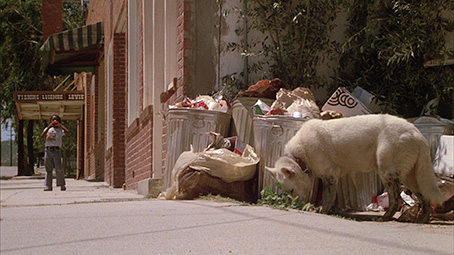
By using an animal as his symbol of racial hatred, Fuller is also able to explore Keys' attempt to break this conditioning at its most basic level. There is none of the thoughtful debate of Made in Britain here, just a daily and exhaustive face-off between man and beast. Dressed in a protective suit, Keys allows the dog to assault him repeatedly until it is too tired to fight, testing his progress by seeing if the animal will take food from his hand without trying to bite it off. There is, we quickly discover, no miracle cure here, no magic moment of realisation for the animal, just small steps over a long period that may or may not count as progress. The question of whether the dog is unlearning his prejudice or just becoming used to Keys also hovers over the proceedings, as is the concern that any progress made might only be temporary, and that the determined Keys will suffer the eventual consequences.
This fear is upped a few notches further when, seemingly halfway through its retraining, the dog makes its escape and heads into town, where it chases a black man into a church and kills him. In what for me is the most extraordinary shot in the film, the bloodied and snarling animal suddenly looks up from the result of his appalling actions and the camera whips across to a stained glass window portraying St. Francis of Assisi with a dog at his feet. In this single shot Fuller not only connects the animal to this iconic image and the killing to the location in which it has taken place, but has the brass balls to suggest a degree of recognition and understanding on the part of the dog at what he has suddenly caught sight of. All power to master cinematographer Bruce Surtees (check out this man's filmography – it'll drop your jaw), editor Bernard Gribble and uncredited camera operator Owen Marsh here for making what should seem absurd hit like an electric shock.
For Julie this is the point at which she discards her belief in the possibility or even validity of redemptive retraining and insists instead that the animal be killed. That Keys rejects her pleas and refuses to abandon his self-set task is probably the film's most credibility-pushing suggestion, yet we buy into it nonetheless because by this point the process of reversing the animal's conditioning has grown from a quest to an all-encompassing obsession. For him this is no longer just about retraining a dog, it's symbolic of his battle against racism itself, and if racism is learned behaviour then true victory requires him to re-educate the perpetrator rather than put a bullet in his head. For Keys, it's the attitude itself that must be confronted and defeated. Whether this is an achievable or even realistic goal is another matter entirely.
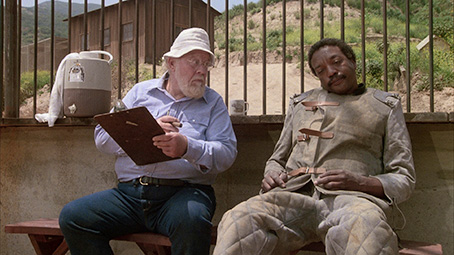
Such biting social commentary brings serious depth and emotional clout to an already involving interpersonal drama, but crucially it works in partnership with character and narrative and never overwhelms them. As a former journalist, Fuller is a storyteller first and knows how to keep his audience hooked, and is fully aware of the cinematic potential of pitting his characters against what Julie's boyfriend tellingly describes as a four-legged time-bomb. This reaches a brief but memorable nail-chewing peak when the animal gets loose and a young boy steps out of his doorway and... no, you need to see that one for yourselves. It builds to an initially chilling but still satisfying verbal confrontation and a tense finale that provides no easy answers, and leaves you with plenty to ponder on after the final credits have rolled.
Adapted by Fuller and L.A. Confiential's Curtis Hanson from a Life magazine story by Romain Gary, and hauntingly scored by Ennio Morricone (oh yes), White Dog is late career Sam Fuller at his incisive and no-nonsense best. A solid cast serves him well (there are even brief cameos from cult fave Dick Miller, Corman graduate Paul Bartel and Fuller himself for those who enjoy spotting such things), but in the end it's the title character – or the five different dogs that were employed to play him – that steals the acting honours, notably in a stunningly executed circular reveal in the film's final moments that really will send a shiver up your spine.
Of course, in retrospect it seems almost absurd that such a blatantly anti-racist film could have once found itself accused of being the very opposite, and concerns about controversy saw Paramount pull it from distribution after only a few screenings. Its critical reception was nonetheless largely positive, particularly in France and the UK, where it enjoyed a more successful cinema release courtesy of United International Pictures. The film's growing cult status and eventual championing by a wider range of critics and the good people at Criterion came too late for Fuller, whose last Hollywood film this turned out to be.
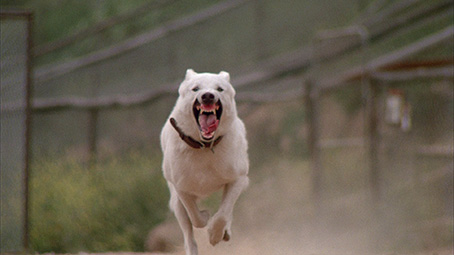
White Dog really is an extraordinary work and one of my favourite films from one of my favourite filmmakers. What astonished me after not having seen it for some years is that it's lost none of its power or, rather sadly, its topical relevance. There's so much more I could talk about here, but in deference to Fuller I'm going to let him have the last word. In this brief extract from a piece written by him for Daily Variety in 1982, reproduced in full in the accompanying booklet, Fuller ostensibly interviews the film's canine star, who becomes the mouthpiece for Fuller's own views when he says of the film:
"They'll call it un-American, socialistic, communistic, liberal crap – anything to muzzle an outcry on film against a disease created by man. I've never met an animal bigot. Never. Can you imagine horses lynching a zebra because of its stripes? Or a lion attacking an ape because of religion? When we have rabies, you humans call us mad dogs. Hell, rabies is an infectious virus disease of our central nervous system. We didn't create it or nurture it. We don't raise puppies to believe that rabies is the right way to exist. We don't raise cubs to hate the colour of another animal's hide. A rabid dog is as helpless as the white dog in the movie, but in all canine history there is no record of an adult dog conditioning a puppy to have rabies. Man, you people boast, is the highest form of animal. Nonsense! Man is capable of hatred. Animals are not, never were, never will be. Man, with all your scientific brilliance, is a very primitive species, billions of years behind the nature of all animals."
Amen to that.
On a number of occasions when I've got all excited about how well a film from my youth has scrubbed up on Blu-ray, fellow reviewer Camus has reminded me that there is no reason why it shouldn't, given the inherent strengths of 35mm film. But of course I get excited, not for how the film should look but for how for many years it too often did. That's certainly the case with White Dog, as although I first saw it on a cinema screen, my strongest memories were of the grubby 4:3 cropped VHS transfer that I was subsequently forced to rely on. I never got around to buying the Criterion DVD, so to suddenly see the film looking as good as it does here was a significant thrill. Featuring a new HD 1080p presentation of the uncut version of the film, supervised by producer Jon Davidson, the transfer here is a fine thing to behold. The colours are pleasingly natural (ah, those were the days) but pop nicely when they need to – Julie's boyfriend's orange VW Beetle is a good example – and the contrast is close to perfect in the sunlit daylight exteriors. The black levels are solid and do swallow detail in sequences set at night, but they have clearly been lit with this look in mind so it always feels right for the scene. The level of detail leaves you in no doubt that you've got a Blu-ray in your player – on a couple of close-ups of the dog's eyes you'll be able to count every surrounding white hair. Film grain is visible, but very low key. The framing, as is so often the way with HD makeovers these days, is 1.78:1.
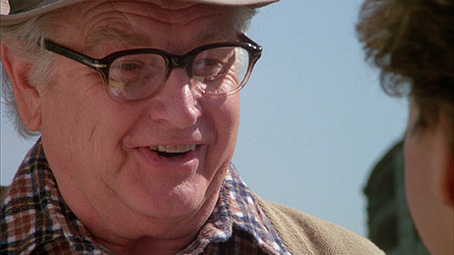
The LPCM 2.0 mono soundtrack has the sort of range restriction I'd normally associate with earlier, low budget films, but is otherwise clean and the dialogue is always clear. Morricone's score is particularly well served here.
Optional English SDH subtitles are also included.
That there are none on the disc itself is a genuine surprise for a Masters of Cinema release, particularly given the interviews included on the 2008 Criterion DVD. What we do have is the expected Booklet, which includes a reproduction of the detailed 1991 Chicago Reader review by Jonathan Rosenbaum, the above-quoted article in which Fuller interviews the dog, a scrapbook of quotes from Fuller and film writer Erik Luers, credits, stills, and a nicely done double-exposure cover picture.
It's always a buzz when a film you once championed but have not seen for some time turns out to everything you remember, and White Dog is certainly that, a ballsy and impeccably handled political drama that, rather sadly, is every bit as relevant now as it was back in the early 80s. The lack of on-disc extras is a tad disappointing, but the film is excellent, the booklet first-rate and the transfer spot-on, so this still comes highly recommended.
|